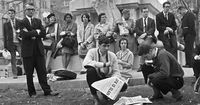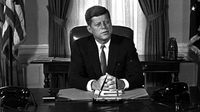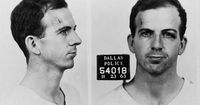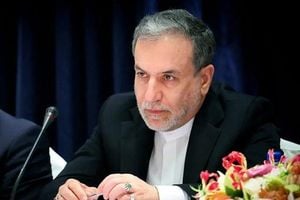DALLAS — The release of over 1,100 declassified documents related to the 1963 assassination of President John F. Kennedy has reignited speculation about the circumstances surrounding his death, challenging the longstanding narrative that Lee Harvey Oswald acted alone. The files, made public on March 19, 2025, reveal intricate details about Oswald's international connections, hinting at a much broader conspiracy than previously acknowledged.
The “lone gunman” theory asserts that Oswald was the sole assassin of Kennedy, who was killed in Dallas while riding in a motorcade on November 22, 1963. Historical records, including the findings of the 1964 Warren Commission, concluded that Oswald, a former Marine, fired the fatal shots. However, with the recent documents unveiling possible connections to intelligence agencies and organized crime, questions regarding the veracity of that narrative have resurfaced.
Upon release of the files, President Donald Trump emphasized their significance, stating, “We have a tremendous amount of paper. You’ve got a lot of reading.” These acquired insights stem not only from the contents of the over 5 million pages previously disclosed but also from new records that include previously classified and redacted material related to the assassination.
Among the files, one notable revelation details the surveillance conducted on Oswald by U.S. intelligence agencies, which tracked his activities closely before and during his defection to the Soviet Union. A memo shows the CIA had monitored a man at the Soviet embassy in Mexico City who claimed to be Oswald; however, discrepancies in photographic evidence created a fog of confusion that persisted through the investigation. “Photos of a man visiting the Soviet Embassy claiming to be Oswald didn’t match his known appearance,” noted the files (JFK File 198-10005-10018).
Additionally, Oswald’s interactions with Soviet and Castro-affiliated officials have been scrutinized, suggesting he may have been embedded in larger political intrigues. Surprisingly, less than five out of 26 similar cases in such high-stake situations involved defectors returning with their spouses, adding further intrigue to his biography (JFK File 1704-104.70213).
In the days leading up to the assassination, a chilling report from the FBI indicated that Oswald “hinted at something big happening weeks before JFK was killed” (JFK File 180-10143-10227). This provocative statement drew interest, especially when considering Oswald’s apparent agitated state at the time. Moreover, connections between Oswald and Jack Ruby, the man who killed him two days after Kennedy’s assassination, have been highlighted, suggesting meetings between the two several weeks prior to the event (JFK File 194-10012-10030).
FBI records shed light on Ruby’s connections, revealing that he had ties to organized crime, raising questions about the motivation behind Oswald’s killing. FBI documents state, “Ruby’s connections to the mob made people think JFK’s assassination was part of a bigger plot” (JFK File 198-10007-10021), leading many to theorize that his act was not merely one of vengeance, but possibly an effort to silence a key witness. Ruby himself reportedly claimed he “had to kill Oswald” (JFK File 197-10002-10190), reiterating speculation about orchestrated chaos behind the scenes.
The release of this memetic history has not only highlighted the differing narratives surrounding Oswald, but it also raised questions about the competency and accountability of intelligence agencies involved. “The CIA and FBI had the chance to connect the dots on Oswald but failed to do so adequately,” analysts argue, deepening suspicions that certain elements intended to obscure the truth.
Findings also indicated that some involved military conspiracies had links stretching across the globe, particularly regarding CIA operations in Cuba due to tensions with Fidel Castro. According to a CIA memo referencing the Cuban operation, officials noted that Oswald had come under surveillance due to his inquiries into potential travel to Cuba (JFK File 198-10005-10018). These intersections underscore the Cold War climate that may have contributed to an environment where Kennedy's assassination could be rationalized through the lens of political expediency.
On March 18, 2025, the National Archives expanded this history, releasing documents that further dissected the physical evidence surrounding the assassination. Critics have berated the handling of physical evidence, notably the so-called “magic bullet,” which allegedly caused all the damage leading to Kennedy's death. The handling of Kennedy’s body and the primary evidence was scrutinized for inconsistencies, especially as multiple witnesses reported hearing shots from various locations, with some suggesting a second shooter on the infamous “grassy knoll.” This theory challenges the premise that just one individual was responsible for such a monumental event.
Further critiques arose concerning the circumstances of Ruby's death. The nightclub operator’s cancer-led death preempted any future testimony which could have revealed pertinent details about a potential conspiracy, raising questions around his motivations and links to organized crime (JFK File 198-10007-10013).
Despite the attempts to untangle the web of secrets, many believe that definitive answers regarding the assassination might elude the public. A Gallup poll indicated that as many as 38% of Americans believe the government played a role in Kennedy's death, while 65% think additional people were involved (2023 Gallup poll). The enduring interest in this case continues to captivate not only conspiracy theorists but also serious analysts seeking to understand political motivations behind such historical tragedies.
As the public wades through these thousands of documents, experts caution against overselling the impact of the newly unveiled files. However, within the intricacies of Kennedy’s death, numerous threads remain to be traced, which could yet unlock answers long dormant. In the pursuit of the truth surrounding John F. Kennedy’s assassination, the newly released files represent a significant development, as speculation reignites around one of America’s most enduring mysteries.






